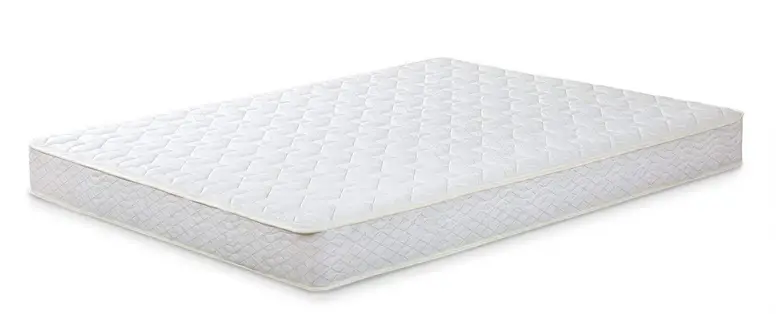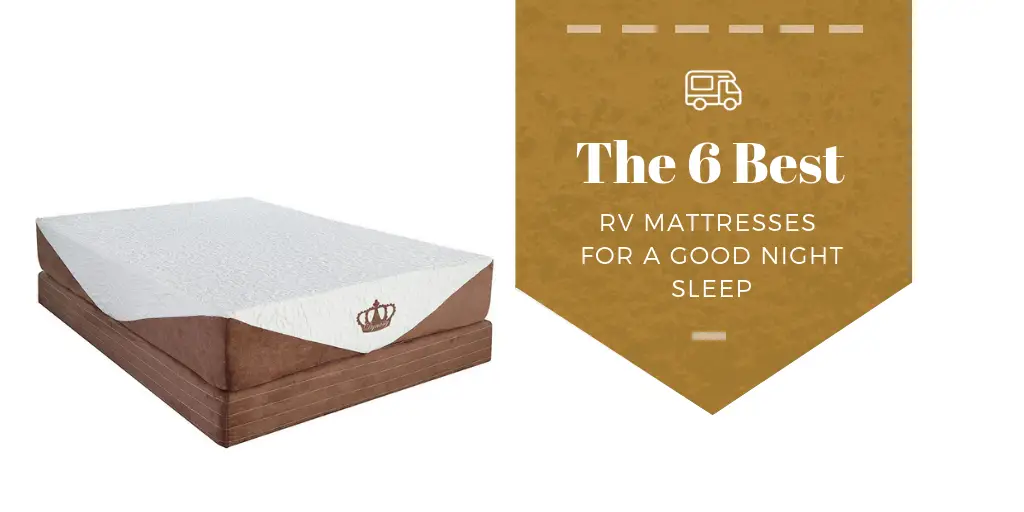
6 Best RV Mattresses in 2019 For a Good Night Sleep
An RV or a camper is a second home for a lot of people. In fact, if you lead a nomadic life, it may even be your primary residence. This means you spend a lot of time in them and most certainly will be in there for at least 7-8 hours, when you sleep.
One thing that always surprises me is when people spend a lot of money on various gadgets for their RVs, but still sleep on the same flimsy hard mattress that came with their camper when they first bought it. Some of them are more than ten years old and while tires, pumps, heaters and everything else has been replaced, somehow the old dirty mattress still survives and people complain about their bad necks and backs and how awful sleeping in a camper is.
If you are anything like me, you know how important a good night sleep is. It is even more important when traveling, and a quality mattress is the key. Getting a new mattress for your RV is slightly different from buying one for your house or apartment. There are a lot of mattresses on the market, each meant for a different type of RV. For the purpose of this article, I’ve reviewed some of the most popular RV mattresses out there so you don’t have to go to the trouble.
Table of Contents
Best RV Mattresses Out There
1. Best Latex RV Mattress- PlushBeds 8″ Natural Latex RV Mattress
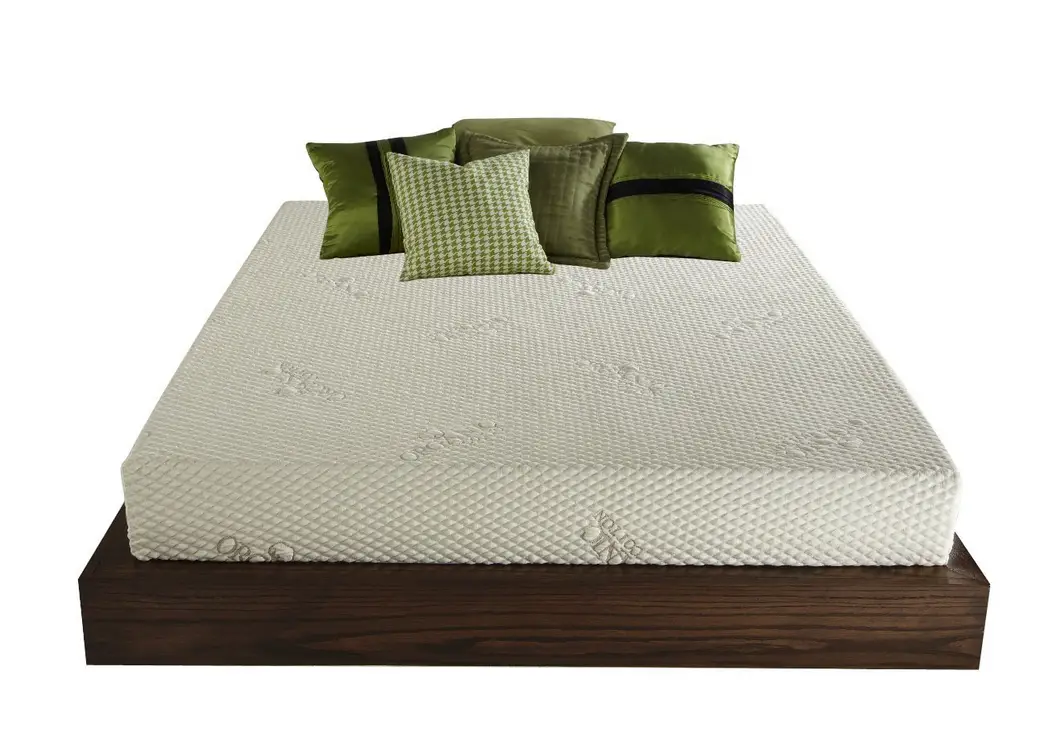 The PlushBeds 8″ Natural Latex RV Mattress, as the name suggests, is made of 100% natural latex foam. There are no fillers or toxic additives used, so you don’t have to worry about the off-gassing of harmful toxins.
The PlushBeds 8″ Natural Latex RV Mattress, as the name suggests, is made of 100% natural latex foam. There are no fillers or toxic additives used, so you don’t have to worry about the off-gassing of harmful toxins.
Most RV mattresses are available in 5-6” of thickness to accommodate different RVs. However, this PlushBeds mattress has a thickness of 8”. This makes it a lot more comfortable than most RV mattresses — allowing it to provide better weight distribution and reduce pressure points — but it can also be used in fewer RVs.
This model can only be used in Class A or Class B motorhomes or really large RVs. Beside the thickness, this mattress has dimensions of 75″ x 48″ and it weighs about 50 pounds.
The upper layer is made of two inches of natural latex. However, it also consists of a lighter six-inch core made of Plushfoam, a CertiPUR accredited material that reduces the overall weight of the product. The entire mattress is then covered with a thin cotton cover.
I found this mattress to fulfill its promise of pressure relief and breathability. Even in really hot conditions, the material does stick to your back, and it is generally quite cool to the touch. I also found it to be lightweight enough to easily install in a moderately-sized RV.
While I can’t personally attest to this mattress’ longevity (since I haven’t used it very long), I have it on good authority that it retains its shape for several years without sagging, breaking, or discoloring.
If you order this mattress online — as I did — it will arrive rolled up. It is at its most portable in this rolled-up state. Thus, you should carry it into the RV and place it as close to the bed’s fixture as possible before unfolding it. Once you have spread it out, the mattress is quite difficult to move.
This mattress gave me very little to complain about. It delivered on all of its advertised promises and it bore no odor at all. However, if I had to complain about something, it would be about the firmness. The mattress is medium-firm. This may be suitable for some people, but I found it to be a little harder than what I’m used to. As such, I wish the seller’s provided more firmness options.
Pros
- 100% natural latex with no fillers or chemical additives
- Delivers on all of its promises regarding quality, longevity, and odorless-ness
- Easy to carry when still rolled up
Cons
- Doesn’t come in different firmness levels
- Once opened, it can be difficult to move
2. Best Polyurethane Foam RV Mattress- AmericanMade Conventional Mattress 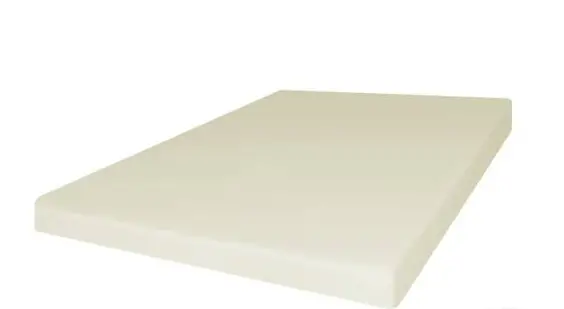
This AmericanMade Conventional Mattress is essentially a 3” thick slab of firm foam. It is extremely lightweight at thirty-three pounds, making it one of the best polyurethane foam mattresses on the market. If you find it too stiff, you can use a separate memory foam topper to soften it up.
Unlike natural latex mattresses, polyurethane foam mattresses place an emphasis on durability and versatility rather than comfort. Being only three inches thick, they can accommodate just about any RV out there. However, you cannot compare its comfort level to that of mattresses made with superior quality materials because it simply won’t live up.
While using this mattress, I often found myself twisting and turning because it was quite firm and didn’t come with enough support, but that is expected with a polyurethane foam mattress. However, I can say that it’s a better and more comfortable mattress than others of the same quality. It’s extremely firm to begin with, but it gradually starts to conform to your body’s shape to heighten comfort over time.
This review might sound harsh, but I can assure you that is not the intention. As mentioned, you buy a polyurethane foam mattress because it is durable, lightweight and cheap, especially if you are only going to use it intermittently. You don’t buy it for luxury. As such, this polyurethane foam mattress delivers on all of its promises, so I cannot fault it over all.
In fact, the great thing about this mattress is that you can purchase it and avail yourself of a thirty-day return policy as well. You can use it for thirty days, and if you find it’s not to your liking, you can return it for a full refund. I found this to be extremely generous because mattress companies don’t often incorporate a return policy into their products (for obvious reasons).
Another good thing about this mattress is that it is multi-purpose. During the day, you can fold it and strap it into a futon position to use as a make-shift couch and then unfold it at night into a bed. If you have a sharp blade, the foam is firm enough, so you can neatly slice this mattress to suit your needs.
Pros
- Firm and dense material
- Extremely affordable
- No chemicals used
- Comes with a return policy
- Can be folded up or cut neatly
- Better than most other polyurethane foam mattresses because the foam conforms to the shape of the body over time
Cons
- Too firm for some users and has to be softened with an additional topper
- While it’s cheap compared to other types of mattresses, it’s still quite expensive considering it’s essentially just a $5 slab of foam.
3. Zinus Ultima Comfort — Best Memory Foam RV Mattress
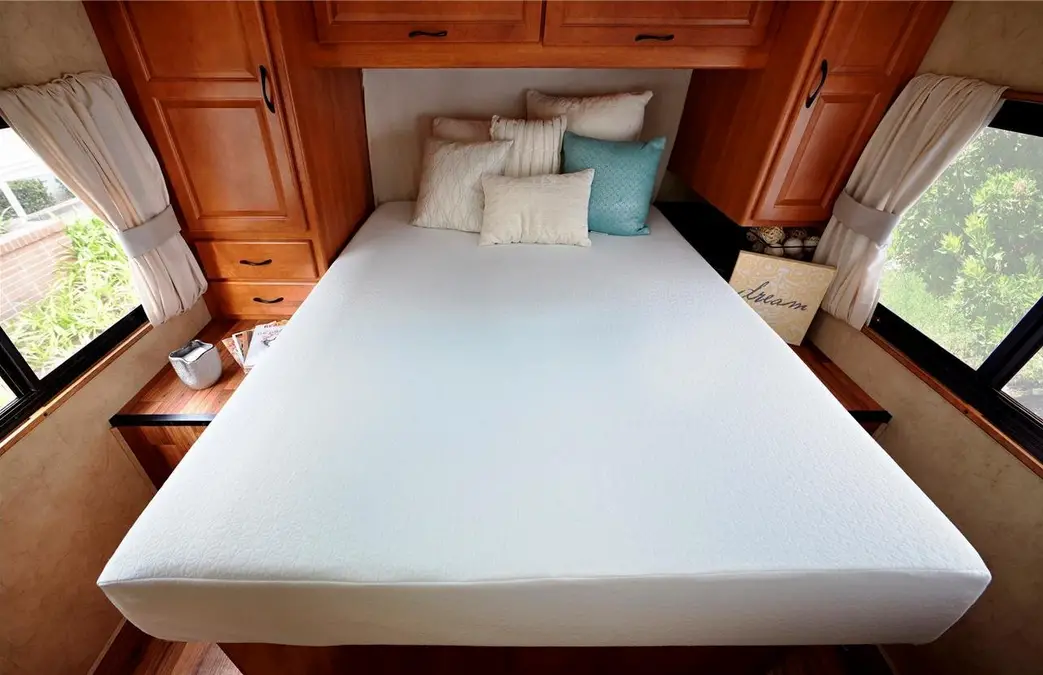 The Zinus Ultima Comfort is an 8” memory foam mattress. It is comprised of three distinct layers — an upper layer of 2” memory foam, a middle layer of 2” pressure-relieving comfort foam, and a final layer of 4” high-density base support foam. Together, these three layers provide softness and comfort with just the right amount of firmness.
The Zinus Ultima Comfort is an 8” memory foam mattress. It is comprised of three distinct layers — an upper layer of 2” memory foam, a middle layer of 2” pressure-relieving comfort foam, and a final layer of 4” high-density base support foam. Together, these three layers provide softness and comfort with just the right amount of firmness.
There are a lot of petroleum and natural plant oil-based memory foam mattresses out there, which cause allergies and exude chemical byproducts. This memory foam mattress, however, is entirely natural and made of bio-foam. It is also CertiPUR-US Certified so it has been thoroughly vetted for durability and fire-resistance.
Being 8” thick — and with dimensions of 74” x 60” — this RV mattress can only be used in the largest of RVs and Class A motorhomes. It weighs 42 pounds, so it’s quite a bit lighter than several other 8” RV mattresses of similar dimensions. However, the benefit of an 8” memory foam mattress is that you don’t need an additional topper.
The softness of the mattress, however, can be a boon and a curse. Being generally lightweight at around 150 pounds, I didn’t have any trouble with the softness. In fact, I found it to be just soft enough, so I didn’t sink in but still felt comfortable.
However, I had a heavier-set colleague (around 250 pounds) try it, and he completely sunk in. Upon further research, I found this to be a recurring complaint among heavier individuals. The mattress is too soft for heavy-set guys and gals out there; and it may, over time, lose its shape. As such, depending on your weight, you might want to skip this mattress.
A common issue that people often have with foam mattresses is that they retain body heat. Their temperature generally runs hotter than most mattresses, which can be an issue in hot climates. However, this mattress has been infused with natural green tea extract to maintain its freshness, absorb the moisture and prevent heat generation. So, even if you’re living in hot conditions, this mattress won’t retain your body heat, and you’ll find it to be cool every time.
Many users of this mattress complain about an odor. When you open the mattress for the first time, you will find that it exudes the smell of fresh paint. Off-gassing is a common occurrence for all mattresses, especially the foam type. However, rest assured that this mattress hasn’t been made with harmful chemicals and airing it out for about 48 hours will get rid of the odor.
Pros
- Comfortable for most light individuals
- Made of all natural bio-foam mattress
- No chemicals used
- Natural green tea extract used to maintain freshness
Cons
- Can be uncomfortable for heavier individuals
- Over time, it can sag in the middle if heavy-set individuals have been using it
4. Best Innerspring RV Mattress- Zinus 8 Inch Spring Mattress
The Zinus 8 Inch Spring Mattress is an 8” innerspring RV mattress comprised of five distinct layers — an upper knitted jacquard cover, followed by a micro-fiber quilted fabric, followed by 0.5” of high-density support foam, 1” of green tea Viscolatex foam, and a final 6” layer of innerspring support system.
Innerspring is a great material to add softness and bounce to a mattress. However, if it is not covered by spring “pockets” and buffered via other layers, this can cause discomfort. To prevent discomfort arising from the springs, this mattress consists of four other layers — including a foam layer — to buffer the effects of the innerspring.
The mattress is originally rolled up and compressed when shipped. You should open it close to your bed and allow about 48 hours for it to gradually blow up and regain its original shape and size. It is also infused with green tea extract and natural castor seed oil to prevent bacterial growth, absorb moisture and mitigate odor.
Flipping is a great means of ensuring the longevity of a mattress as both sides experience equal wear. However, this innerspring mattress only has one finished side so it cannot be flipped. It also cannot be folded as a substitute sofa or to make it fit into smaller camper vans. After it expands into its original shape, it retains that shape. As such, you should only purchase it if you’re sure it can fit into your RV comfortably.
I found this mattress to be quite comfortable when sleeping on my own. However, it might pose some difficulty if you’re sharing the bed with someone else. The springs vibrate considerably whenever someone moves. As such, your partner’s movements might affect your sleep.
Furthermore, if you’re a heavy-set individual, you might find that there isn’t enough padding between you and the springs, and you might feel their hardness on your back. I believe this mattress would have greatly benefited from some additional foam buffering. A lot of users say that they had to get a foam topper to add some additional buffer and reduce the hardness. That should not be necessary.
Pros
- Green tea extract and natural castor seed oil help keep the mattress fresh and comfortable
- The springs add great bounce and there’s padding between the springs and the upper layer
Cons
- Could have used some more buffering
- Cannot be flipped as only one side is properly finished
5. Best Gel-Infused RV Mattress- DynastyMattress 10GEL-QUEEN-RV
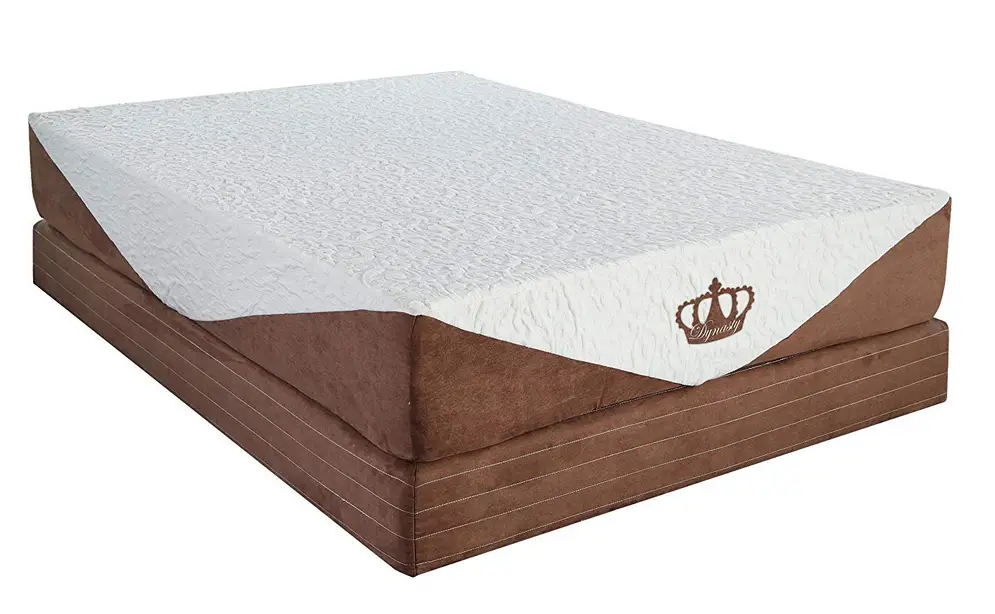 The DynastyMattress 10GEL-QUEEN-RV is a 10” gel-infused memory foam mattress. It is comprised of the following layers — 2.5” upper layer of CoolBreeze gel-infused high-density memory foam, 4” of cool airflow foam, and 3.5” of medium-firm foam as the base. The three layers have been structured to provide the ideal level of softness and firmness, and they are covered with a white and brown suede cover that can be removed with the zipper and washed.
The DynastyMattress 10GEL-QUEEN-RV is a 10” gel-infused memory foam mattress. It is comprised of the following layers — 2.5” upper layer of CoolBreeze gel-infused high-density memory foam, 4” of cool airflow foam, and 3.5” of medium-firm foam as the base. The three layers have been structured to provide the ideal level of softness and firmness, and they are covered with a white and brown suede cover that can be removed with the zipper and washed.
Besides the 10” thickness, it has dimensions of 75 x 60 inches and weighs 55 pounds. It’s quite a large mattress and can only be used in large RVs. When you first receive your shipment, the mattress will be in a compact rolled-up form. You need to let it out, preferably where the bed frame is located, and allow it to blow back out and regain its original shape over 48 hours.
As a gel-infused memory foam mattress, this mattress provides the comfort and softness of a memory foam while also incorporating the cooling essence and breathability of the get beads. Even if you’re sweating on hot nights, the mattress has been designed to keep your back cool.
Some of the other mattresses on this list have issues for the heavier-set. Since this mattress is gel-infused and 10” thick, I assumed it would be too soft for heavy people. However, I was pleasantly surprised that it’s just as comfortable for me (a 150-pound man) as for those who weigh around 280 pounds.
Furthermore, upon contacting other individuals who have used this mattress for several years, I have been told that it retains its shape with no depression or sagging over time.
The only thing that concerns me about this mattress is the consistency. Upon unboxing it, you’re supposed to give it about 24 to 48 hours to fluff up completely. However, many users complain that even after fluffing up completely, there are spots that don’t fluff up all the way. This might be due to air pockets within the mattress and it creates an uncomfortable and uneven surface to sleep on.
Pros
- Extremely comfortable for individuals of all weights and sizes
- Gel beads keep you cool during hot days
- Highly breathable material
Cons
- Some users have complained of the uneven surface
6. Best Air RV Mattress- SoundAsleep Dream Series
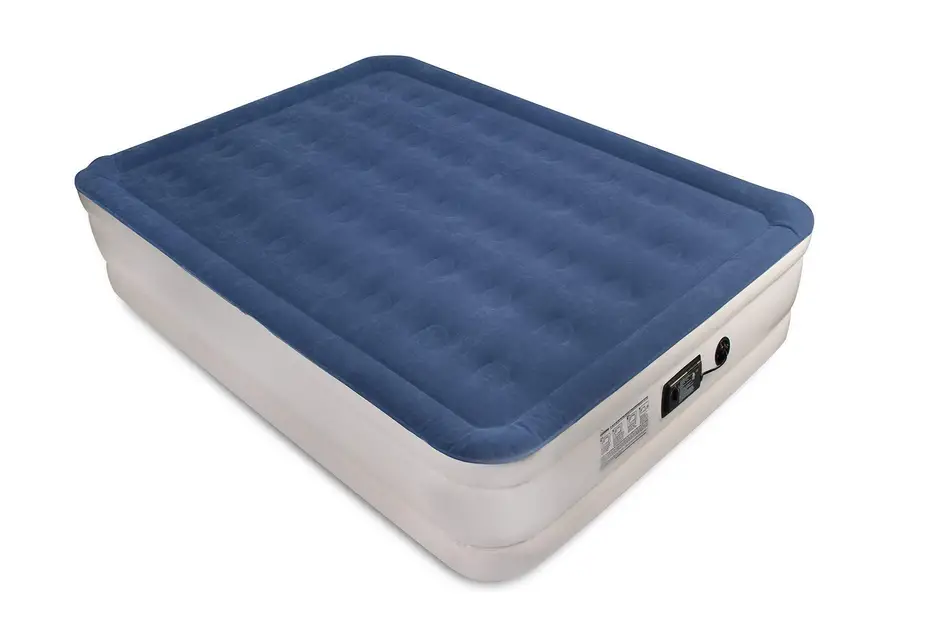 This SoundAsleep Dream Series air mattress has been designed with Comfort Coil technology, using 40 air coils to enhance comfort. Inflating and deflating the mattress is fairly easy: a single click of the pump is all it takes and you simply need to wait for it to inflate or deflate. It takes approximately five minutes for the mattress to fill up entirely.
This SoundAsleep Dream Series air mattress has been designed with Comfort Coil technology, using 40 air coils to enhance comfort. Inflating and deflating the mattress is fairly easy: a single click of the pump is all it takes and you simply need to wait for it to inflate or deflate. It takes approximately five minutes for the mattress to fill up entirely.
When using an air mattress like this, it’s important to note that it is meant for temporary use. This mattress can serve you well for about two months. However, if you need to use it beyond that, you must be extremely careful. After you receive the mattress, it is advisable to fully inflate and deflate it a few times to allow the composite material to stretch out completely. Air mattresses need to be broken in to be really comfortable, and repeated inflation and deflation should achieve this. You should also top the mattress with about 10-15 seconds of air every couple of days to keep it firm and well inflated. Finally, if you intend to use this mattress for several weeks or months, you should use a mattress pad to enhance longevity.
This mattress has been designed for indoor use, so you cannot use it on camping expeditions. However, you can set it up in your RV if you have a wall power outlet within close range. It has an internal motor that needs to be hooked to the power outlet. There is no external motors and no batteries available for inflation; as such, you can only use it indoors.
Furthermore, the thickness of the mattress has been designed for use on an even surface. If you intend to use it in your RV for a few weeks, it will work great. However, you cannot carry it with you if you decide to go on camping expeditions.
Pros
- Inflates and deflates quickly
- Comfortable construction
Cons
- Can only be used indoors and needs a wall power outlet for inflation
RV Mattresses Buyer’s Guide
In this section, I’ll give you a detailed survey of RV mattresses. I’ll answer some of the most common questions about RV mattresses and give you an overview of the factors to consider when buying them.
How are RV mattresses different from regular mattresses?
- The mattress foam used in RV mattresses is completely different from regular ones. Since they have to fit into smaller frames, they are six inches shorter than regular mattresses.
- You get a range of different sizes, but all are specific to RVs and their dimensions.
- RV mattresses are supposed to be lighter to reduce the overall weight of the RV.
- RVs often contain beds with rounded frames to accommodate cupboards and washrooms. As such, RV mattresses are designed to meet those atypical shapes.
How To Install a Mattress to an RV?
There are a number of ways to add mattresses to your RV to save space. Here are the most popular methods:
- Install the bed in the back of the RV, running end to end. This will allow you to stretch out leaving plenty of space for other things.
- If you’re fine with narrow beds for single individuals, you can set up a double bunker bed on one side of the RV.
- You can install a complete bed down the length of the RV and use the remaining space along the sides for storage.
What is the Best Mattress for an RV?
RVs have different space specifications. Some can only accommodate small bunk beds whereas others can hold any kind of bed. It’s important to consider the type of RV you have before selecting a mattress. The following are the different types of RVs along with the mattresses they can accommodate.
Motorhomes
Motorhomes are RVs that are driven rather than towed by a vehicle. They do not require a commercial driver’s license (CDL) either. These are some of the most expensive and largest RVs on the market. They can be divided into the following sub-categories according to their size:
- Class A: The largest motorhomes measure up to 50 feet in length. They can generally accommodate RV mattresses of any dimension.
- Class B: Easier to handle than Class A, but also featuring less space, they are some of the most popular motorhomes. They are between 30 and 40 feet in length and have plenty of storage. Most of them can accommodate RV mattresses of any size.
- Class C: These measure just 20 to 30 feet in length and are usually not big enough for RV mattresses. As such, they have to settle for pull-out sofas or toppers for their sofas and bunk beds.
Fifth Wheel Trailers
These are the largest towable trailers on the market with enough space to fit any RV mattress size. They are made of two components — the towing vehicle and the trailer. This makes them easy to maneuver during turns or while reversing.
Travel Trailers
These are similar to fifth wheel trailers, but they don’t have a coupling to hook the trailer to a towing vehicle. As such, they are harder to maneuver and the towing vehicle cannot easily back up. They are long and narrow, and thus can’t usually accommodate full-size mattresses.
Pop Up Trailers
These are the smallest towable trailers with limited sleeping quarters that are not very comfortable and are only meant for short camping trips. They also don’t come with many features and are minimalist in design to save space. As such, they cannot accommodate large or thick mattresses.
What Materials are used for RV Mattresses Available?
The following are the different types of materials available for RV mattresses. The material is important because it determines the most important factors — cost, durability, portability, and comfort.
Latex
Latex mattresses are meant for both comfort and support. There are a number of different types of latex mattresses on the market — dunlop, talalay, synthetic, and natural.
Natural latex is the best of these. It’s a completely organic material made from a rubber tree. It’s more comfortable than synthetic materials, antimicrobial and anti-allergic, and also more durable. However, latex RV mattresses are also extremely expensive, large, and heavy, and thus can’t be used in all vehicles.
You should generally avoid using dunlop, talalay, or synthetic latex materials as they are processed using chemicals that can be hazardous.
Polyurethane Foam
Polyurethane Foam — often called only foam — is the most commonly used material for RV mattresses. It’s thin and firm, and thus can be accommodated in most RVs. However, it’s also quite uncomfortable and not very durable. If you don’t have a lot of space in your RV, or if you have budgetary constraints, you’ll have to settle for a good polyurethane foam.
Memory Foam
Memory foam mattresses have a base of sturdy foam material but are topped by a layer of soft memory foam. As such, they remain thin and firm, capable of fitting into most RVs. However, they are also comfortable, or at least more comfortable than polyurethane foam mattresses.
The most distinct aspect of a memory foam mattress is that it doesn’t snap back immediately after the weight has been lifted off. As such, it will bear the imprint of your body for several minutes or even hours after you get off. Some people prefer it this way because the bed can be “broken in” for heightened personalized comfort.
Innerspring
Innerspring or coil mattresses are high-quality and made bouncy with the use of coils underneath the mattress layers. The coils and springs are usually topped off with foam memory foam or another soft material.
While they are durable, however, they can be uncomfortable for two people. Any movements made by one sleeper can interrupt the other as well. In order to avoid this, most companies have wrapped all the individual coils within pockets.
Innerspring mattresses are also some of the heaviest mattresses out there, so they’re not ideal for pop-up trailers or a nomadic life. Furthermore, they contain metal elements that can also rust and corrode if exposed to natural elements like moisture.
Gel-Infused
These foam mattresses contain cooling gel beads. These add some comfort to otherwise uncomfortable foam mattresses, and they can also lower the temperature. As such, these are a great option if you live in hot climates.
Air Mattress
Air mattresses can either be extremely expensive or extremely cheap. These come in a number of different types so be sure to get an RV air mattress. Some of the more expensive mattresses even allow you to adjust the amount of air present on both sides of the bed, which can help you adjust the softness depending on the sleeper’s preference.
They are also durable, lightweight, and highly portable. As a result, they can fit into most RVs. The biggest drawback here is that many air mattresses require electric power.
Factors to Consider when Buying an RV Mattress
The following are some of the most vital features and factors to consider when buying an RV mattress.
Size
The sizing structure of RV mattresses is different than that followed by regular mattresses because RVs have limited space. The following is a brief summary of the different RV mattress dimensions (W x L):
- Twin — 38” x 75”
- Twin XL — 38” x 80”
- Full or Double — 54” x 75”
- Queen — 60” x 80”
- King — 76” x 80”
- California King — 72” x 84”
Use the aforementioned size chart to determine which of these sizes your RV can accommodate.
Material
As mentioned, RV mattresses are available in six distinct materials — latex, polyurethane foam, memory foam, innerspring, gel-infused, and air mattress. All of these materials have their advantages and disadvantages. You need to consider which is suitable for your needs and can also be accommodated in your RV.
Thickness
RV mattresses need to fit into the RVs sleeping quarters. They are generally between 5 to 6 inches thick, and never over 10 inches. Generally speaking, the thicker the mattress, the more comfortable it is. However, greater thickness also takes up more space in the RV.
Firmness
Most RV mattresses are quite firm. However, if you prefer a softer mattress, you should go for memory foam, latex, or innerspring types.
Portability and Durability
It’s possible that you might have to move the mattress often. If so, make sure that it’s lightweight enough to conveniently handle on your own, if necessary.
You should also focus on practical considerations to ensure durability, so it stays with you for several years. Make sure that the mattress meets the regulations for biodiversity upkeep. Also ensure that the mattress hasn’t been made of illegal substances like formaldehyde, lead, mercury, etc, that can prove to be hazardous to one’s health. To make sure your mattress is of the highest quality possible, check that it is CertiPUR-US certified.
Warranty
RV mattresses have shorter warranty periods than regular mattresses because they are used in rougher conditions. The average RV mattress warranty is between 5-10 years, although some high-end RV mattresses also come with 20-25 year warranties. You should steer clear of cheap RV mattresses without any warranty coverage.
How Much Should You Spend on an RV Mattress?
RV mattresses can be extremely cheap (less than $150) and extremely expensive (over $1000). Most comfortable and durable mattresses can be found in the $500 bracket. However, make sure that it has been properly certified, has a warranty, and is made of a durable material.
What is the Best RV Mattress for Camping?
The best RV type for camping is a foam mattress. This might not be as comfortable as some other mattresses, but it can withstand external elements like a change in temperature, moisture, etc.
Innerspring mattresses, in comparison, are quite comfortable. But they are also more susceptible to rusting and corrosion when used outdoors. Air mattresses are convenient for their portability, but some require electric power so they’re not ideal for camping.
Are all RV Mattresses Fireproof?
In 2007, the US government passed regulations that necessitated that all mattresses be fireproof. This happened as a result of a large number of deaths occurring due to smoking in bed.
Currently, all mattresses have to pass the Consumer Product Safety Commission’s (CPSP) open flame fire test. So yes, all mattresses are fireproof. But that doesn’t necessarily mean that they’re all safe.
In order to pass the CPSP’s test, many mattress companies have resorted to using cheap fireproofing chemicals. Over a period of time, these chemicals continue to release gas from the mattress that sleepers will inhale. Over time, these mattresses can produce harmful side-effects and pose health hazards.
Many companies, however, use fire-resistant materials that are more expensive and also completely safe. These include fiberglass, wool, kevlar, and various others. These materials pass the open flame fire test and pose no known health hazards.
As such, you should make sure that the fireproofing of your mattress uses only natural fire-resistant materials and not chemicals. All of the mattresses recommended in this article meet these standards.
How to Off-Gas an RV Mattress?
Off-gassing is a process wherein a mattress gradually exudes the chemicals that were used during production. All mattresses — even those made entirely of organic materials — off-gas initially.
This off-gassing process continues gradually for several years after the mattress is purchased. However, it is advisable to allow the mattress to air out for about 48 hours immediately. This is the period when most of the chemicals will dissipate. After that period, if you’ve purchased an all-natural mattress, the chemicals exuded through off-gassing will be too negligible to really matter.
You should ideally off-gas your mattress in a confined space such as a garage or basement.
Conclusion
I hope this article has helped you figure out the best RV mattress for your specific needs. That said, rest up and sleep tight!



